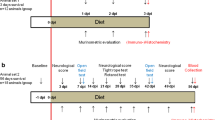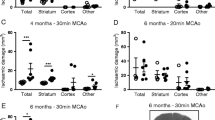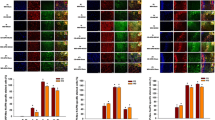Abstract
Obesity is categorized as a common comorbidity found in people who experience an ischemic stroke. However, the mechanisms to explain this correlation have still not been elucidated fully. Pyroptosis and necroptosis are novel forms of programmed cell death that occur upon intracellular danger signals. The major feature of pyroptosis and necroptosis is damage to the lipid membrane, which consequently results in lytic cell death and allows the release of high mobility group box protein 1 (HMGB1) into the extracellular space. We aimed to investigate the influences of high-fat diet (HFD) consumption on cerebral ischemia and reperfusion (I/R) injury and hypothesized that HFD consumption exacerbated the activation of pyroptosis, necroptosis, and HMGB1 signaling pathways. All rats received normal diet (ND) or HFD for 16 weeks. Subsequently, both groups were divided into either a sham- or an I/R-operated group. Twenty-four hours after the surgery, all rats were evaluated for neurological deficits and then sacrificed. After I/R injury, there were more severe functional deficits and larger brain infarcts in the HFD compared with the ND group. The histological observation revealed an increase in tissue abnormalities in the HFD group, consistent with the massive reduction of intact neurons along the peri-infarct region. Furthermore, cerebral I/R injury dramatically activated the pyroptotic, necroptotic, and HMGB1 signaling pathways in HFD-fed rats compared with ND-fed rats. These findings suggest that chronic HFD consumption worsens ischemic brain pathology and leads to poor post-stroke outcomes by exacerbating pyroptotic and necroptotic cell death.







Similar content being viewed by others
References
Arenillas JF, Sandoval P, Perez de la Ossa N, Millan M, Guerrero C, Escudero D, Dorado L, Lopez-Cancio E, Castillo J, Davalos A (2009) The metabolic syndrome is associated with a higher resistance to intravenous thrombolysis for acute ischemic stroke in women than in men. Stroke 40:344–349. https://doi.org/10.1161/STROKEAHA.108.531079
Boaru SG, Borkham-Kamphorst E, Van de Leur E, Lehnen E, Liedtke C, Weiskirchen R (2015) NLRP3 inflammasome expression is driven by NF-κB in cultured hepatocytes. Biochem Biophys Res Commun 458:700–706. https://doi.org/10.1016/j.bbrc.2015.02.029
Chen J, Kos R, Garssen J, Redegeld F (2019) Molecular insights into the mechanism of necroptosis: the necrosome as a potential therapeutic target. Cells 8:1486. https://doi.org/10.3390/cells8121486
Chen J, Yang C, Xu X, Yang Y, Xu B (2018) The effect of focal cerebral ischemia-reperfusion injury on TLR4 and NF-κB signaling pathway. Exp Ther Med 15:897–903. https://doi.org/10.3892/etm.2017.5463
Datta A, Sarmah D, Mounica L, Kaur H, Kesharwani R, Verma G, Veeresh P, Kotian V, Kalia K, Borah A et al (2020) Cell death pathways in ischemic stroke and targeted pharmacotherapy. Transl Stroke Res 11:1185–1202. https://doi.org/10.1007/s12975-020-00806-z
Deguchi I, Ohe Y, Fukuoka T, Dembo T, Nagoya H, Kato Y, Maruyama H, Horiuchi Y, Tanahashi N (2012) Relationship of obesity to recanalization after hyperacute recombinant tissue-plasminogen activator infusion therapy in patients with middle cerebral artery occlusion. J Stroke Cerebrovasc Dis 21:161–164. https://doi.org/10.1016/j.jstrokecerebrovasdis.2011.11.003
Del Re DP, Amgalan D, Linkermann A, Liu Q, Kitsis RN (2019) Fundamental mechanisms of regulated cell death and implications for heart disease. Physiol Rev 99:1765–1817. https://doi.org/10.1152/physrev.00022.2018
Deng XX, Li SS, Sun FY (2019) Necrostatin-1 prevents necroptosis in brains after ischemic stroke via inhibition of RIPK1-mediated RIPK3/MLKL signaling. Aging Dis 10:807–817. https://doi.org/10.14336/AD.2018.0728
Donkor ES (2018) Stroke in the 21(st) century: a snapshot of the burden, epidemiology, and quality of life. Stroke Res Treat 2018:3238165. https://doi.org/10.1155/2018/3238165
Frank D, Vince JE (2019) Pyroptosis versus necroptosis: Similarities, differences, and crosstalk. Cell Death Differ 26:99–114. https://doi.org/10.1038/s41418-018-0212-6
Gauberti M, Lapergue B, Martinez de Lizarrondo S, Vivien D, Richard S, Bracard S, Piotin M, Gory B (2018) Ischemia-reperfusion injury after endovascular thrombectomy for ischemic stroke. Stroke 49:3071–3074. https://doi.org/10.1161/STROKEAHA.118.022015
Gou X, Xu D, Li F, Hou K, Fang W, Li Y (2021) Pyroptosis in stroke-new insights into disease mechanisms and therapeutic strategies. J Physiol Biochem. https://doi.org/10.1007/s13105-021-00817-w
Gray N, Picone G, Sloan F, Yashkin A (2015) Relation between BMI and diabetes mellitus and its complications among us older adults. South Med J 108:29–36. https://doi.org/10.14423/SMJ.0000000000000214
Grisotto C, Taile J, Planesse C, Diotel N, Gonthier MP, Meilhac O, Couret D (2021) High-fat diet aggravates cerebral infarct, hemorrhagic transformation and neuroinflammation in a mouse stroke model. Int J Mol Sci 22:4571. https://doi.org/10.3390/ijms22094571
Hribljan V, Lisjak D, Petrovic DJ, Mitrecic D (2019) Necroptosis is one of the modalities of cell death accompanying ischemic brain stroke: From pathogenesis to therapeutic possibilities. Croat Med J 60:121–126. https://doi.org/10.3325/cmj.2019.60.121
Jaikumkao K, Pongchaidecha A, Chueakula N, Thongnak L, Wanchai K, Chatsudthipong V, Chattipakorn N, Lungkaphin A (2018) Renal outcomes with sodium glucose cotransporter 2 (SGLT2) inhibitor, dapagliflozin, in obese insulin-resistant model. Biochim Biophys Acta Mol Basis Dis 1864:2021–2033. https://doi.org/10.1016/j.bbadis.2018.03.017
Jaikumkao K, Promsan S, Thongnak L, Swe MT, Tapanya M, Htun KT, Kothan S, Intachai N, Lungkaphin A (2021) Dapagliflozin ameliorates pancreatic injury and activates kidney autophagy by modulating the AMPK/mTOR signaling pathway in obese rats. J Cell Physiol 9:6424–6440. https://doi.org/10.1002/jcp.30316
Kim EH, Wong SW, Martinez J (2019) Programmed necrosis and disease: we interrupt your regular programming to bring you necroinflammation. Cell Death Differ 26:25–40. https://doi.org/10.1038/s41418-018-0179-3
Kuriakose D, Xiao Z (2020) Pathophysiology and treatment of stroke: present status and future perspectives. Int J Mol Sci 21.https://doi.org/10.3390/ijms21207609
Lin L, Wang X, Yu Z (2016) Ischemia-reperfusion injury in the brain: mechanisms and potential therapeutic strategies. Biochem Pharmacol (Los Angel) 5. https://doi.org/10.4172/2167-0501.1000213
Lee HJ, Choi EK, Lee SH, Kim YJ, Han KD, Oh S (2018) Risk of ischemic stroke in metabolically healthy obesity: a nationwide population-based study. PLoS ONE 13:e0195210. https://doi.org/10.1371/journal.pone.0195210
Lee RM, Choi H, Shin JS, Kim K, Yoo KH (2009) Distinguishing between apoptosis and necrosis using a capacitance sensor. Biosens Bioelectron 24:2586–2591. https://doi.org/10.1016/j.bios.2009.01.028
Litwin M, Kulaga Z (2021) Obesity, metabolic syndrome, and primary hypertension. Pediatr Nephrol 36:825–837. https://doi.org/10.1007/s00467-020-04579-3
Liu T, Zhang L, Joo D, Sun SC (2017) Nf-kappab signaling in inflammation. Signal Transduct Target Ther 2:17023. https://doi.org/10.1038/sigtrans.2017.23
Maysami S, Haley MJ, Gorenkova N, Krishnan S, McColl BW, Lawrence CB (2015) Prolonged diet-induced obesity in mice modifies the inflammatory response and leads to worse outcome after stroke. J Neuroinflamm 12:140. https://doi.org/10.1186/s12974-015-0359-8
Mostafa DG, Satti HH, Khaleel EF, Badi RM (2020) A high-fat diet rich in corn oil exaggerates the infarct size and memory impairment in rats with cerebral ischemia and is associated with suppressing osteopontin and Akt, and activating GS3Kβ, iNOS, and NF-κB. J Physiol Biochem 76:393–406. https://doi.org/10.1007/s13105-020-00744-2
Ryan F, Khodagholi F, Dargahi L, Minai-Tehrani D, Ahmadiani A (2018) Temporal pattern and crosstalk of necroptosis markers with autophagy and apoptosis associated proteins in ischemic hippocampus. Neurotox Res 34:79–92. https://doi.org/10.1007/s12640-017-9861-3
Shahjouei S, Cai PY, Ansari S, Sharififar S, Azari H, Ganji S, Zand R (2016) Middle cerebral artery occlusion model of stroke in rodents: a step-by-step approach. J Vasc Interv Neurol 8:1–8
Shi Z, Yuan S, Shi L, Li J, Ning G, Kong X, Feng S (2021) Programmed cell death in spinal cord injury pathogenesis and therapy. Cell Prolif 54:e12992. https://doi.org/10.1111/cpr.12992
Sivasinprasasn S, Wikan N, Tocharus J, Pantan R, Chaichompoo W, Suksamrarn A, Tocharus C (2019) Synergistic effects of the capsaicinoid nonivamide and rosuvastatin on obesity-related endothelial dysfunction in rat fed a high-fat diet. Phytother Res 33:1815–1826. https://doi.org/10.1002/ptr.6369
Srinivasan K, Viswanad B, Asrat L, Kaul CL, Ramarao P (2005) Combination of high-fat diet-fed and low-dose streptozotocin-treated rat: a model for type 2 diabetes and pharmacological screening. Pharmacol Res 52:313–320. https://doi.org/10.1016/j.phrs.2005.05.004
Wang H, Chen H, Jin J, Liu Q, Zhong D, Li G (2020) Inhibition of the NLRP3 inflammasome reduces brain edema and regulates the distribution of aquaporin-4 after cerebral ischaemia-reperfusion. Life Sci 251:117638. https://doi.org/10.1016/j.lfs.2020.117638
Wikan N, Tocharus J, Sivasinprasasn S, Kongkaew A, Chaichompoo W, Suksamrarn A, Tocharus C (2020) Capsaicinoid nonivamide improves nonalcoholic fatty liver disease in rats fed a high-fat diet. J Pharmacol Sci 143:188–198. https://doi.org/10.1016/j.jphs.2020.03.008
Yawoot N, Govitrapong P, Tocharus C, Tocharus J (2021) Ischemic stroke, obesity, and the anti-inflammatory role of melatonin. BioFactors 47:41–58. https://doi.org/10.1002/biof.1690
Ye Y, Zeng Z, Jin T, Zhang H, Xiong X, Gu L (2019) The role of high mobility group box 1 in ischemic stroke. Front Cell Neurosci 13:127. https://doi.org/10.3389/fncel.2019.00127
Zhang D, Qian J, Zhang P, Li H, Shen H, Li X, Chen G (2019) Gasdermin D serves as a key executioner of pyroptosis in experimental cerebral ischemia and reperfusion model both in vivo and in vitro. J Neurosci Res 97:645–660. https://doi.org/10.1002/jnr.24385
Zhao H, Chen Z, Xie LJ, Liu GF (2018) Suppression of TLR4/NF-κB signaling pathway improves cerebral ischemia-reperfusion injury in rats. Mol Neurobiol 55:4311–4319. https://doi.org/10.1007/s12035-017-0552-0
Funding
This study was supported by Functional Food Research Center for Well-Being, Chiang Mai University and the Royal Golden Jubilee PhD program (grant number PHD/0104/2561).
Author information
Authors and Affiliations
Contributions
The authors declare that all data were generated in-house and that no paper mill was used. Jiraporn Tocharus designed the conception in this study; Nuttapong Yawoot performed experiments and collected data; Wijitra Chumboatong and Jirakhamon Sengking performed experiments; Nuttapong Yawoot, Chainarong Tocharus, and Jiraporn Tocharus performed data analysis and investigation; Nuttapong Yawoot performed an original draft of manuscript; Nuttapong Yawoot, Chainarong Tocharus, and Jiraporn Tocharus edited and reviewed the manuscript. All authors read and approved for the final draft of the manuscript.
Corresponding author
Ethics declarations
All experimental procedures in animals were carried out according to a protocol approved by the Laboratory Animal Center, Chiang Mai University, Thailand, following the guidelines established by the National Institutes of Health.
Conflict of interest
The authors declare no competing interests.
Additional information
Publisher's note
Springer Nature remains neutral with regard to jurisdictional claims in published maps and institutional affiliations.
Key points
1. Obesity promoted an increase in brain infarct volume and worsened neurological outcomes after cerebral ischemia and reperfusion injury.
2. Obesity exacerbated pyroptotic and necroptotic cell death after cerebral ischemia and reperfusion injury.
3. Obesity exacerbated the HMGB1/TLR4/NF-κB signaling pathway after cerebral ischemia and reperfusion injury.
Rights and permissions
About this article
Cite this article
Yawoot, N., Chumboatong, W., Sengking, J. et al. Chronic high-fat diet consumption exacerbates pyroptosis- and necroptosis-mediated HMGB1 signaling in the brain after ischemia and reperfusion injury. J Physiol Biochem 78, 833–844 (2022). https://doi.org/10.1007/s13105-022-00906-4
Received:
Accepted:
Published:
Issue Date:
DOI: https://doi.org/10.1007/s13105-022-00906-4




